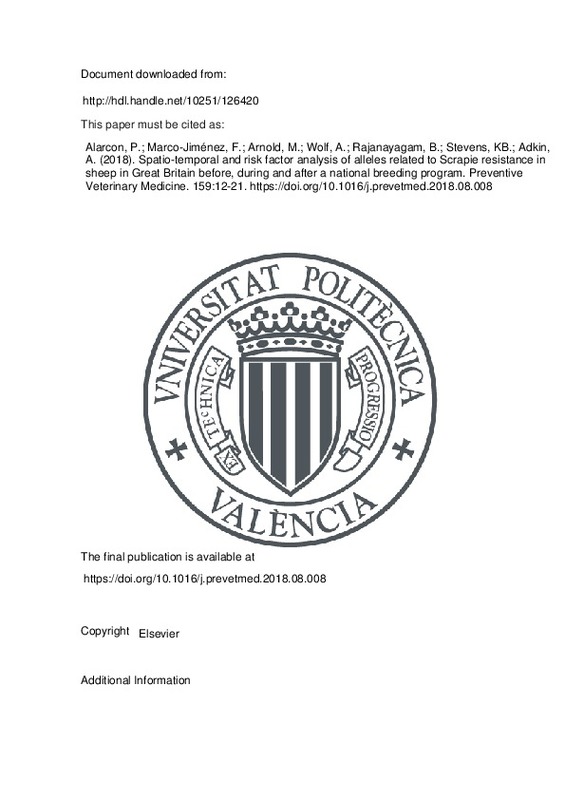JavaScript is disabled for your browser. Some features of this site may not work without it.
Buscar en RiuNet
Listar
Mi cuenta
Estadísticas
Ayuda RiuNet
Admin. UPV
Spatio-temporal and risk factor analysis of alleles related to Scrapie resistance in sheep in Great Britain before, during and after a national breeding program
Mostrar el registro sencillo del ítem
Ficheros en el ítem
| dc.contributor.author | Alarcon, P.
|
es_ES |
| dc.contributor.author | Marco-Jiménez, Francisco
|
es_ES |
| dc.contributor.author | Arnold, Mark
|
es_ES |
| dc.contributor.author | Wolf, Alyssa
|
es_ES |
| dc.contributor.author | Rajanayagam, Brenda
|
es_ES |
| dc.contributor.author | Stevens, Kim B.
|
es_ES |
| dc.contributor.author | Adkin, Amie
|
es_ES |
| dc.date.accessioned | 2019-09-26T10:05:23Z | |
| dc.date.available | 2019-09-26T10:05:23Z | |
| dc.date.issued | 2018 | es_ES |
| dc.identifier.issn | 0167-5877 | es_ES |
| dc.identifier.uri | http://hdl.handle.net/10251/126420 | |
| dc.description.abstract | [EN] Certain genotypes of sheep have been identified to increase their susceptibility (the VRQ allele) or resistance (the ARR allele) to classical scrapie. This study's aim was to assess the spatio-temporal pattern of the ARR and VRQ alleles in Great Britain (GB) and to explore the risk factors associated to their presence. Data was collected from the GB scrapie active surveillance program, the sheep and goat inventory survey (GB census survey) and the agricultural survey for the period 2002-2015. Spatio-temporal trends of genotypes were assessed through the use of choropleth maps, spatial cluster and linear regression analyses. Multivariable mixed effect logistic regression analyses were performed to investigate the association between the resistant or susceptible genotypes, and breeds, farm purpose, animal purpose, surveillance stream, country location and herd size. The results show a significant upward trend in the frequency of most resistant ARR alleles (1.15% per year, 95%CI: 0.76-1.53) and significant downward trend of most susceptible VRQ alleles (-0.40% per year; 95%CI: -0.69 to -0.10]. The trend continues after the termination of the national scrapie plan in 2009. Breeds such as Herdwick (OR = 0,26; 95%CI: 0.14-0.46), Shetland (OR = 0.22; 95%CI: 0.13-0.39), Swaledale (OR = 0.58; 95%CI: 0.47-0.73), Scottish blackface (OR = 0.54; 95%CI: 0.41-0.71) and Welsh Montain (OR: 0.59; 95%CI: 0.44-0.79) were identified with lower odds ratios of having the resistant ARR allele, while Beulah speckled face (OR = 1.58; 95%CI: 1.04-2.41), Jacob (OR = 2.91; 95%CI: 1.33-6.40), Lleyn (OR = 2.94; 95%CI: 1.28-6.74) and Suffolk (OR = 2.19; 95%CI: 1.69-2.84) had higher odds ratios of having the ARR allele. Other risk factors associated to presence of ARR allele were finishing farms (OR = 1.15; 95%CI: 1.06-1.24) and farms in Scotland (OR = 0,78; 95%CI: 0.73-0.83) and in Lowland grazing areas (OR = 1.53; 95%CI: 1.39-1.67). Factors associated with presence the VRQ genotype were farms in Scotland (OR = 0,85; 95%CI: 0.77-0.93) and breeds such as Herdwick (OR = 2.2; 95%CI: 1.08-4.97), Shetland (OR = 4.12; 95%CI: 2.20-7.73) and Sweledale (OR = 1.51; 95%CI: 1.10-2.09). For the most resistant genotype, two significant spatial clusters were identified: a high-risk cluster in the south-west of GB (RR = 1.51, p < 0.001) and a low-risk cluster in northern GB (RR = 0.65, p < 0.001). For the most susceptible genotypes, one significant high-risk cluster was identified in Wales (RR = 2.89 and p = 0.013). Surveillance for classical scrapie could be improved with a risk-based approach by focussing on those areas and farm types identified to have higher frequency of VRQ alleles and less frequency of ARR alleles. Scrapie control strategies could focus on developing breeding programs on farms with Shetland, Herdwick and Swaledale breeds. | es_ES |
| dc.description.sponsorship | The work was funded by the GB Department for Environment, Food and Rural Affairs (Defra) and has been accomplished during the stay of Professor PhD. Francisco Marco-Jimenez at the Animal and Plant Health Agency (APHA-Weybridge) with a grant of Conselleria de Education y Ciencia of Generalitat Valenciana. | es_ES |
| dc.language | Inglés | es_ES |
| dc.publisher | Elsevier | es_ES |
| dc.relation.ispartof | Preventive Veterinary Medicine | es_ES |
| dc.rights | Reconocimiento - No comercial - Sin obra derivada (by-nc-nd) | es_ES |
| dc.subject | Scrapie | es_ES |
| dc.subject | PrP genotype | es_ES |
| dc.subject | Risk factor | es_ES |
| dc.subject | Sheep | es_ES |
| dc.subject | Surveillance | es_ES |
| dc.subject | Cluster analysis | es_ES |
| dc.subject.classification | PRODUCCION ANIMAL | es_ES |
| dc.title | Spatio-temporal and risk factor analysis of alleles related to Scrapie resistance in sheep in Great Britain before, during and after a national breeding program | es_ES |
| dc.type | Artículo | es_ES |
| dc.identifier.doi | 10.1016/j.prevetmed.2018.08.008 | es_ES |
| dc.rights.accessRights | Abierto | es_ES |
| dc.contributor.affiliation | Universitat Politècnica de València. Departamento de Ciencia Animal - Departament de Ciència Animal | es_ES |
| dc.description.bibliographicCitation | Alarcon, P.; Marco-Jiménez, F.; Arnold, M.; Wolf, A.; Rajanayagam, B.; Stevens, KB.; Adkin, A. (2018). Spatio-temporal and risk factor analysis of alleles related to Scrapie resistance in sheep in Great Britain before, during and after a national breeding program. Preventive Veterinary Medicine. 159:12-21. https://doi.org/10.1016/j.prevetmed.2018.08.008 | es_ES |
| dc.description.accrualMethod | S | es_ES |
| dc.relation.publisherversion | https://doi.org/10.1016/j.prevetmed.2018.08.008 | es_ES |
| dc.description.upvformatpinicio | 12 | es_ES |
| dc.description.upvformatpfin | 21 | es_ES |
| dc.type.version | info:eu-repo/semantics/publishedVersion | es_ES |
| dc.description.volume | 159 | es_ES |
| dc.identifier.pmid | 30314774 | |
| dc.relation.pasarela | S\368003 | es_ES |
| dc.contributor.funder | Department for Environment, Food and Rural Affairs, UK Government | |
| dc.contributor.funder | Generalitat Valenciana |







![[Cerrado]](/themes/UPV/images/candado.png)

